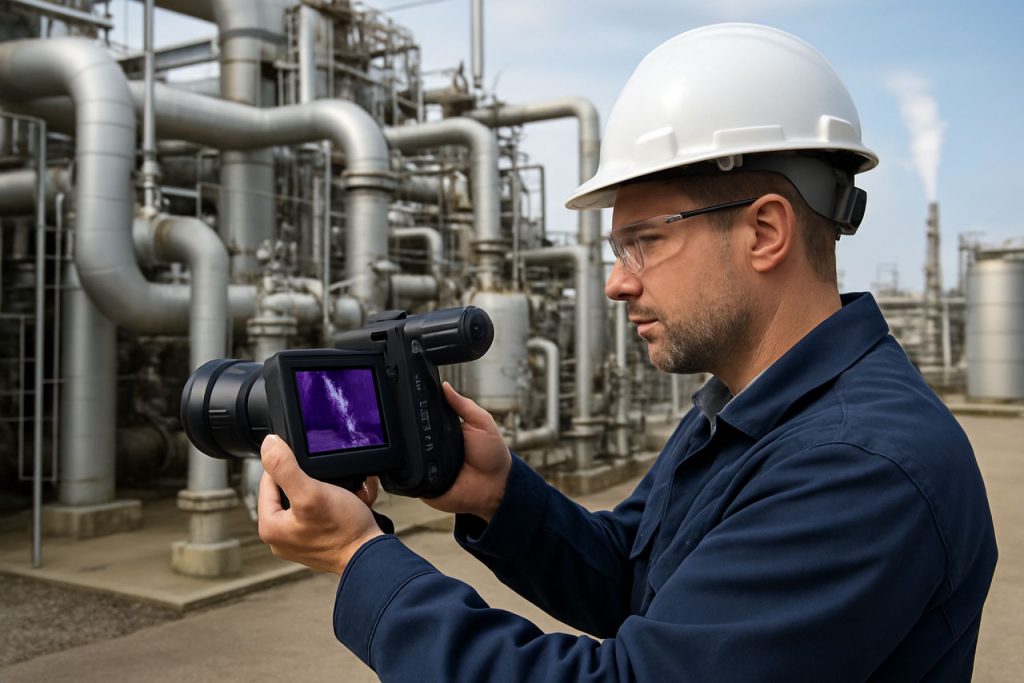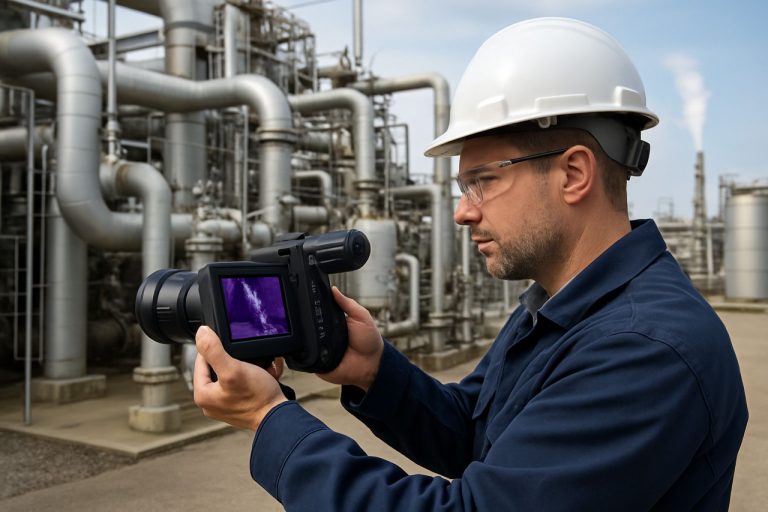
Fugitive Emissions Monitoring in Industrial Facilities 2025: Market Dynamics, Technology Innovations, and Strategic Forecasts. Explore Key Trends, Regulatory Impacts, and Growth Opportunities Shaping the Industry.
- Executive Summary & Market Overview
- Key Market Drivers and Restraints
- Technology Trends: AI, IoT, and Advanced Sensing Solutions
- Competitive Landscape and Leading Players
- Market Size & Growth Forecasts (2025–2030)
- Regional Analysis: North America, Europe, Asia-Pacific, and Rest of World
- Regulatory Environment and Compliance Trends
- Challenges and Opportunities in Fugitive Emissions Monitoring
- Future Outlook: Innovations and Strategic Recommendations
- Sources & References
Executive Summary & Market Overview
Fugitive emissions monitoring in industrial facilities refers to the systematic detection, measurement, and management of unintended releases of gases or vapors from pressurized equipment, such as valves, flanges, pumps, and connectors. These emissions, often comprising volatile organic compounds (VOCs), methane, and other greenhouse gases, pose significant environmental, regulatory, and financial risks. As of 2025, the global market for fugitive emissions monitoring is experiencing robust growth, driven by tightening environmental regulations, heightened corporate sustainability goals, and advancements in detection technologies.
The market is propelled by regulatory frameworks such as the U.S. Environmental Protection Agency’s Leak Detection and Repair (LDAR) requirements, the European Union’s Industrial Emissions Directive, and similar mandates in Asia-Pacific and Latin America. These regulations compel industries—particularly oil & gas, chemicals, and petrochemicals—to implement rigorous monitoring and reporting protocols. According to International Energy Agency, methane emissions from the energy sector alone account for approximately 40% of total methane emissions globally, underscoring the critical need for effective monitoring solutions.
Technological innovation is reshaping the market landscape. Traditional methods, such as periodic manual inspections using portable gas analyzers, are increasingly supplemented or replaced by continuous monitoring systems, infrared cameras, and advanced sensor networks. The integration of artificial intelligence and IoT platforms enables real-time data analytics, predictive maintenance, and automated reporting, enhancing both accuracy and operational efficiency. Leading solution providers, including Honeywell, Teledyne FLIR, and Siemens, are investing heavily in R&D to deliver scalable, cost-effective monitoring platforms.
- The global fugitive emissions monitoring market was valued at approximately USD 2.1 billion in 2023 and is projected to reach USD 2.8 billion by 2025, reflecting a CAGR of around 15% (MarketsandMarkets).
- North America and Europe remain the largest markets, but Asia-Pacific is witnessing the fastest growth due to expanding industrialization and stricter local regulations.
- Key end-user sectors include oil & gas (upstream, midstream, downstream), chemicals, power generation, and manufacturing.
In summary, fugitive emissions monitoring is transitioning from a compliance-driven activity to a strategic imperative for industrial operators. The convergence of regulatory pressure, stakeholder expectations, and technological progress is expected to sustain market momentum through 2025 and beyond.
Key Market Drivers and Restraints
Fugitive emissions monitoring in industrial facilities is increasingly shaped by a combination of regulatory, technological, and economic drivers, as well as notable restraints that impact market growth and adoption rates in 2025.
Key Market Drivers
- Stringent Environmental Regulations: Governments worldwide are tightening emission standards to address climate change and air quality concerns. For instance, the U.S. Environmental Protection Agency and the European Commission have implemented rigorous monitoring and reporting requirements for volatile organic compounds (VOCs) and greenhouse gases (GHGs) in sectors such as oil & gas, chemicals, and manufacturing. These regulations are compelling facilities to invest in advanced monitoring solutions.
- Corporate Sustainability Initiatives: Industrial operators are increasingly prioritizing environmental, social, and governance (ESG) goals. Companies are adopting fugitive emissions monitoring not only for compliance but also to enhance their sustainability credentials and reduce operational risks, as highlighted in CDP reporting frameworks.
- Technological Advancements: Innovations in sensor technology, data analytics, and remote monitoring (including drones and satellite-based systems) are making emissions detection more accurate and cost-effective. According to MarketsandMarkets, the integration of IoT and AI-driven analytics is accelerating adoption by enabling real-time leak detection and predictive maintenance.
- Cost Savings and Operational Efficiency: Early detection of leaks reduces product loss, minimizes safety hazards, and lowers remediation costs. This economic incentive is a significant driver, especially in high-value industries such as petrochemicals and natural gas.
Key Market Restraints
- High Initial Investment: The upfront costs of deploying comprehensive monitoring systems, including hardware, software, and integration, can be prohibitive for small and mid-sized enterprises. This is particularly true for facilities with legacy infrastructure.
- Technical Complexity and Skill Gaps: The operation and maintenance of advanced monitoring technologies require specialized expertise. A shortage of skilled personnel can hinder effective implementation, as noted by International Energy Agency analyses.
- Data Management Challenges: The vast amount of data generated by continuous monitoring systems can overwhelm existing IT infrastructure, complicating data analysis and regulatory reporting.
- Regulatory Uncertainty in Emerging Markets: Inconsistent enforcement and evolving standards in developing regions can deter investment in monitoring solutions, limiting market expansion outside North America and Europe.
Technology Trends: AI, IoT, and Advanced Sensing Solutions
Fugitive emissions monitoring in industrial facilities is undergoing a significant transformation driven by the integration of advanced technologies such as artificial intelligence (AI), the Internet of Things (IoT), and next-generation sensing solutions. As regulatory scrutiny intensifies and sustainability goals become more ambitious, industrial operators are increasingly adopting these technologies to enhance detection accuracy, reduce operational costs, and ensure compliance.
AI-powered analytics are revolutionizing the way facilities process and interpret emissions data. Machine learning algorithms can now analyze vast streams of sensor data in real time, identifying emission anomalies and predicting potential leaks before they escalate. This predictive capability not only minimizes environmental impact but also reduces downtime and maintenance costs. For example, AI-driven platforms are being deployed to automate the classification of emission sources and prioritize maintenance activities, as highlighted in recent industry case studies by IBM and Microsoft.
IoT-enabled networks of sensors are another cornerstone of modern fugitive emissions monitoring. These wireless sensor networks provide continuous, facility-wide coverage, transmitting real-time data to centralized monitoring systems. The proliferation of low-power, long-range IoT devices has made it feasible to deploy hundreds or thousands of sensors across large industrial sites, enabling granular detection of leaks and emissions. According to IoT World Today, the adoption of IoT-based monitoring solutions is expected to grow at a double-digit CAGR through 2025, driven by falling sensor costs and improved connectivity.
Advanced sensing technologies are also reshaping the landscape. Innovations such as open-path laser absorption spectroscopy, tunable diode laser absorption spectroscopy (TDLAS), and optical gas imaging (OGI) cameras are providing unprecedented sensitivity and specificity for detecting volatile organic compounds (VOCs) and greenhouse gases. These technologies are increasingly being integrated with AI and IoT platforms to enable automated leak detection and quantification. For instance, FLIR Systems and Siemens have introduced solutions that combine high-resolution imaging with real-time analytics for rapid identification of fugitive emissions.
Looking ahead to 2025, the convergence of AI, IoT, and advanced sensing is expected to drive further innovation in fugitive emissions monitoring. This will not only help industrial facilities meet tightening regulatory requirements but also support broader environmental, social, and governance (ESG) objectives by enabling more proactive and transparent emissions management.
Competitive Landscape and Leading Players
The competitive landscape for fugitive emissions monitoring in industrial facilities is characterized by a mix of established multinational corporations and innovative technology startups, all vying to address increasingly stringent environmental regulations and the growing demand for real-time, accurate emissions data. As of 2025, the market is witnessing robust growth, driven by regulatory frameworks such as the U.S. EPA’s Leak Detection and Repair (LDAR) requirements and the European Union’s Industrial Emissions Directive, which mandate continuous monitoring and reporting of fugitive emissions in sectors like oil & gas, chemicals, and manufacturing.
Leading players in this space include Honeywell International Inc., Siemens AG, and ABB Ltd., all of which offer comprehensive solutions integrating advanced sensors, data analytics, and cloud-based platforms for emissions detection and management. These companies leverage their global reach, extensive R&D capabilities, and established client relationships to maintain a competitive edge. For instance, Honeywell’s Connected Plant suite and ABB’s Ability™ platform are widely adopted for their scalability and integration with existing plant infrastructure.
Emerging technology providers such as Teledyne FLIR LLC and OptaSense (a QinetiQ company) are gaining traction with innovative optical gas imaging (OGI) cameras and distributed acoustic sensing (DAS) technologies, respectively. These solutions enable rapid, non-intrusive detection of leaks, significantly reducing response times and operational costs. Additionally, startups like Spectral Engines and SeekOps Inc. are introducing drone-based and IoT-enabled monitoring systems, further intensifying competition and expanding the range of available solutions.
- Market Consolidation: The sector is experiencing moderate consolidation, with larger players acquiring niche technology firms to enhance their portfolios and address evolving customer needs. Recent examples include Honeywell’s acquisition of Rebellion Photonics and Siemens’ investment in digital monitoring startups.
- Regional Dynamics: North America and Europe remain the largest markets due to strict regulatory enforcement, while Asia-Pacific is emerging as a high-growth region, propelled by industrial expansion and increasing environmental awareness.
- Innovation Focus: Competitive differentiation is increasingly based on the integration of artificial intelligence, machine learning, and real-time analytics to improve detection accuracy and predictive maintenance capabilities.
Overall, the competitive landscape in 2025 is defined by rapid technological innovation, strategic partnerships, and a clear shift toward digital, automated, and remote monitoring solutions, as industrial operators seek to minimize environmental impact and regulatory risk.
Market Size & Growth Forecasts (2025–2030)
The market for fugitive emissions monitoring in industrial facilities is poised for significant expansion between 2025 and 2030, driven by tightening environmental regulations, technological advancements, and increasing corporate commitments to sustainability. In 2025, the global market size for fugitive emissions monitoring solutions—including hardware, software, and services—is projected to reach approximately USD 2.1 billion, according to estimates from MarketsandMarkets. This figure reflects robust demand across sectors such as oil & gas, chemicals, power generation, and manufacturing, where regulatory compliance and operational efficiency are paramount.
From 2025 to 2030, the market is expected to register a compound annual growth rate (CAGR) of 7.8%, reaching an estimated value of USD 3.1 billion by 2030. This growth trajectory is underpinned by several key factors:
- Regulatory Pressure: Governments in North America, Europe, and Asia-Pacific are intensifying enforcement of emission standards, particularly for methane and volatile organic compounds (VOCs). The implementation of the U.S. EPA’s New Source Performance Standards (NSPS) and the European Union’s Industrial Emissions Directive are notable drivers (U.S. Environmental Protection Agency, European Commission).
- Technological Innovation: Adoption of advanced monitoring technologies—such as optical gas imaging (OGI), laser-based sensors, and IoT-enabled continuous monitoring systems—is accelerating. These solutions offer higher accuracy, real-time data, and lower operational costs, making them attractive for large-scale deployment (Emerson Electric Co.).
- Corporate Sustainability Initiatives: Major industrial players are setting ambitious net-zero and emission reduction targets, further fueling demand for comprehensive monitoring and reporting solutions (Shell plc).
Regionally, North America is anticipated to maintain the largest market share through 2030, owing to stringent regulatory frameworks and early adoption of digital monitoring technologies. However, the Asia-Pacific region is forecasted to exhibit the fastest growth, propelled by rapid industrialization and evolving environmental policies in China, India, and Southeast Asia (Frost & Sullivan).
Overall, the period from 2025 to 2030 will see the fugitive emissions monitoring market transition from compliance-driven adoption to a more integrated, data-centric approach, with digitalization and automation at the forefront of growth.
Regional Analysis: North America, Europe, Asia-Pacific, and Rest of World
The regional landscape for fugitive emissions monitoring in industrial facilities is shaped by regulatory frameworks, industrialization levels, and technological adoption rates. In 2025, North America, Europe, Asia-Pacific, and the Rest of the World (RoW) exhibit distinct market dynamics and growth drivers.
- North America: The region remains a global leader in fugitive emissions monitoring, driven by stringent environmental regulations from agencies such as the U.S. Environmental Protection Agency and Environment and Climate Change Canada. The U.S. oil & gas sector, in particular, is under pressure to comply with methane reduction mandates, spurring investments in advanced leak detection and repair (LDAR) technologies. Adoption of optical gas imaging, continuous monitoring sensors, and drone-based solutions is accelerating, with a focus on real-time data analytics and automation. The presence of major technology providers and a mature industrial base further support market growth.
- Europe: Europe’s market is propelled by ambitious climate targets under the European Commission’s Green Deal and the European Environment Agency’s directives. The region’s chemical, petrochemical, and energy sectors are rapidly deploying advanced monitoring systems to meet strict emission limits. The adoption of IoT-enabled sensors and AI-driven analytics is notable, especially in Germany, France, and the Nordics. Cross-border initiatives and funding for innovation further stimulate the market, while compliance with the Industrial Emissions Directive (IED) remains a key driver.
- Asia-Pacific: Rapid industrialization and urbanization in China, India, and Southeast Asia are increasing the focus on fugitive emissions. Governments are tightening regulations, particularly in China, where the Ministry of Ecology and Environment is enforcing stricter monitoring in the petrochemical and manufacturing sectors. However, the market is fragmented, with varying enforcement levels. Multinational corporations and local players are investing in cost-effective, scalable monitoring solutions, and the adoption of remote sensing and mobile monitoring units is on the rise.
- Rest of World (RoW): In Latin America, the Middle East, and Africa, market growth is moderate but rising, driven by increasing awareness and international pressure to reduce greenhouse gas emissions. Countries with significant oil & gas operations, such as Brazil and Saudi Arabia, are gradually implementing monitoring programs, often in partnership with global technology providers. However, budget constraints and limited regulatory enforcement remain challenges.
Overall, while North America and Europe lead in technology adoption and regulatory compliance, Asia-Pacific and RoW present significant growth opportunities as industrialization and environmental awareness expand in these regions.
Regulatory Environment and Compliance Trends
The regulatory environment for fugitive emissions monitoring in industrial facilities is becoming increasingly stringent in 2025, driven by global efforts to mitigate climate change and improve air quality. Regulatory agencies such as the U.S. Environmental Protection Agency (EPA), the European Commission Directorate-General for Climate Action, and national bodies in Asia-Pacific are tightening standards for the detection, reporting, and reduction of fugitive emissions, particularly volatile organic compounds (VOCs) and methane.
In the United States, the EPA’s New Source Performance Standards (NSPS) and National Emission Standards for Hazardous Air Pollutants (NESHAP) have been updated to require more frequent and comprehensive Leak Detection and Repair (LDAR) programs. The 2024 amendments to the Clean Air Act, effective in 2025, mandate quarterly monitoring for high-risk facilities and the use of advanced technologies such as optical gas imaging (OGI) and continuous monitoring sensors. Facilities are now required to submit digital reports, increasing transparency and enforcement capabilities for regulators (U.S. Environmental Protection Agency).
In the European Union, the Industrial Emissions Directive (IED) and the Methane Strategy are driving harmonization of monitoring requirements across member states. The 2025 revision of the IED introduces stricter Best Available Techniques (BAT) conclusions, compelling operators to implement real-time monitoring and automated data logging for fugitive emissions. The EU is also piloting satellite-based methane detection in collaboration with the European Space Agency (ESA), further enhancing regulatory oversight (European Commission).
In Asia-Pacific, countries such as China and India are aligning with international standards, with China’s Ministry of Ecology and Environment (MEE) rolling out new guidelines for petrochemical and chemical sectors. These guidelines emphasize the adoption of certified monitoring equipment and third-party verification, reflecting a broader trend toward accountability and compliance in emerging markets (Ministry of Ecology and Environment of the People’s Republic of China).
Overall, the compliance landscape in 2025 is characterized by a shift toward digitalization, real-time data acquisition, and integration of advanced detection technologies. Industrial operators face increasing pressure to not only detect and quantify fugitive emissions but also to demonstrate proactive mitigation and transparent reporting, with non-compliance resulting in substantial financial and reputational risks.
Challenges and Opportunities in Fugitive Emissions Monitoring
Fugitive emissions monitoring in industrial facilities is a critical component of environmental compliance and operational efficiency, yet it presents a complex landscape of challenges and opportunities as the sector moves into 2025. Industrial facilities—ranging from oil and gas refineries to chemical plants and manufacturing sites—are under increasing regulatory and societal pressure to detect, quantify, and mitigate unintentional releases of gases such as methane, volatile organic compounds (VOCs), and hazardous air pollutants.
One of the primary challenges is the sheer scale and complexity of industrial sites. Facilities often span vast areas with intricate networks of pipes, valves, and storage units, making manual leak detection labor-intensive and prone to oversight. Traditional methods, such as periodic handheld inspections, are not only time-consuming but may also miss intermittent or small leaks that cumulatively contribute significantly to total emissions. Moreover, regulatory frameworks are tightening globally, with agencies like the U.S. Environmental Protection Agency and the European Commission Directorate-General for Climate Action introducing stricter monitoring and reporting requirements, increasing the compliance burden on operators.
However, these challenges are driving significant opportunities for innovation and market growth. The adoption of advanced technologies—such as optical gas imaging (OGI), continuous monitoring sensors, and drone-based detection systems—is accelerating. These solutions offer real-time, high-resolution data, enabling faster response times and more accurate quantification of emissions. For example, the deployment of continuous monitoring networks can provide facility operators with actionable insights, supporting predictive maintenance and reducing the risk of regulatory violations. According to MarketsandMarkets, the global market for leak detection and repair (LDAR) systems is projected to grow substantially, driven by both regulatory mandates and the operational benefits of early leak detection.
- Data Integration and Analytics: The integration of monitoring data with advanced analytics platforms is enabling predictive insights and automated reporting, streamlining compliance and operational decision-making.
- Cost Considerations: While upfront investment in advanced monitoring technologies can be significant, the long-term savings from reduced product loss, lower regulatory penalties, and improved safety are compelling drivers for adoption.
- Global Expansion: Emerging markets are increasingly adopting fugitive emissions monitoring solutions, spurred by international climate commitments and local air quality concerns.
In summary, while fugitive emissions monitoring in industrial facilities faces persistent challenges related to scale, complexity, and regulatory compliance, the sector is poised for transformation through technological innovation and data-driven strategies in 2025.
Future Outlook: Innovations and Strategic Recommendations
The future outlook for fugitive emissions monitoring in industrial facilities is shaped by rapid technological innovation, evolving regulatory landscapes, and increasing stakeholder pressure for environmental accountability. As industries prepare for 2025, several key trends and strategic recommendations are emerging to address the challenges and opportunities in this sector.
Technological Innovations
- Advanced Sensing Technologies: The adoption of next-generation sensors, including laser-based open-path detectors, tunable diode laser absorption spectroscopy (TDLAS), and photoacoustic sensors, is expected to accelerate. These technologies offer higher sensitivity, real-time data, and the ability to detect a broader range of volatile organic compounds (VOCs) and greenhouse gases (ION Science).
- Integration of IoT and AI: The integration of Internet of Things (IoT) devices with artificial intelligence (AI) and machine learning algorithms is transforming emissions monitoring. Predictive analytics can now identify leak patterns, optimize maintenance schedules, and reduce false positives, leading to more efficient operations (Emerson Electric Co.).
- Remote and Autonomous Monitoring: The deployment of drones and autonomous robots equipped with multi-sensor arrays is gaining traction, particularly in hard-to-reach or hazardous areas. These systems enable continuous, high-frequency monitoring and rapid response to detected leaks (Sensirion AG).
Strategic Recommendations
- Proactive Compliance: With regulatory bodies such as the U.S. Environmental Protection Agency (EPA) and the European Commission tightening emissions standards, facilities should invest in systems that not only meet current requirements but are adaptable to future regulations.
- Data-Driven Decision Making: Facilities should leverage big data analytics to gain actionable insights from emissions data, enabling targeted interventions and resource optimization (Schneider Electric).
- Stakeholder Engagement: Transparent reporting and engagement with local communities, investors, and regulators will be critical. Adopting third-party verification and publishing emissions data can enhance trust and corporate reputation.
- Continuous Training: Ongoing workforce training in new monitoring technologies and regulatory requirements will ensure operational excellence and safety.
In summary, the future of fugitive emissions monitoring in industrial facilities will be defined by digital transformation, regulatory foresight, and a commitment to sustainability. Early adoption of innovative solutions and strategic planning will position organizations for compliance, efficiency, and long-term value creation in 2025 and beyond.
Sources & References
- International Energy Agency
- Honeywell
- Siemens
- MarketsandMarkets
- European Commission
- CDP
- IBM
- Microsoft
- ABB Ltd.
- OptaSense (a QinetiQ company)
- Spectral Engines
- SeekOps Inc.
- European Commission
- Emerson Electric Co.
- Shell plc
- Frost & Sullivan
- Environment and Climate Change Canada
- European Environment Agency
- Ministry of Ecology and Environment
- European Space Agency (ESA)
- ION Science
- Sensirion AG



